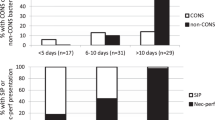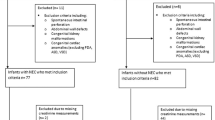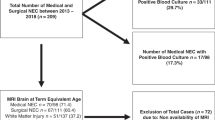Abstract
We report a 27-week, 850 g infant with severe Streptococcus group B sepsis and life-threatening hyperkalemia due to progressive anuria. On the fourth day of life, after he failed treatment with diuretics, salbutamol, insulin, calcium gluconate and sodium bicarbonate, he was treated with sorbitol-free Kayexalate enemas. Potassium level slowly decreased from 9.2 mmol/l to normal level along with a recovery of normal urine output. On the 11th day of life, clinical and radiological signs of a perforated necrotizing enterocolitis (NEC) occurred and the patient required surgical intestinal resection. Histologic examination of the ileum specimen revealed areas of necrosis with fibrosis and giant cell reaction to a nonpolarizable material consistent with sodium polystyrene sulfonate. Usually, Kayexalate is suspended in hyperosmolar sorbitol solutions and the elevated osmolarity seems to be responsible for hemorrhagic colitis, transmural necrosis and definitely NEC. Our case report shows that Kayexalate per se, and not necessarily suspended in sorbitol, can lead to gastrointestinal tract complications and NEC in preterm infants.
This is a preview of subscription content, access via your institution
Access options
Subscribe to this journal
Receive 12 print issues and online access
$259.00 per year
only $21.58 per issue
Buy this article
- Purchase on Springer Link
- Instant access to full article PDF
Prices may be subject to local taxes which are calculated during checkout

Similar content being viewed by others
References
Chandler JC, Hebra A . Necrotizing enterocolitis in infants with very low birth weight. Semin Pediatr Surg 2000; 9: 63.
Scherr L, Ogden DA, Mead AW, Spritz N, Rubin AL . Management of hyperkalemia with a cation-exchange resin. N Engl J Med 1961; 264: 115–119.
Bennett LN, Myers TF, Lambert GH . Cecal perforation associated with sodium polystyrene sulfonate-sorbitol enemas in a 650 gram infant with hyperkalemia. Am J Perinatol 1996; 13: 167–170.
Milley JR, Jung AL . Hematochezia associated with the use of hypertonic sodium polystyrene sulfonate enemas in premature infants. J Perinatol 1995; 15: 139–142.
Chlumska A, Boudova L, Pavlovsky M, Sulc M . Intestinal necrosis following Calcium Resonium-sorbitol administration in a premature uraemic infant. Cesk Patol 2002; 38: 169–172.
Grammatikopoulos T, Greenough A, Pallidis C, Davenport M . Benefits and risks of calcium resonium therapy in hyperkalaemic preterm infants. Acta Paediatr 2003; 92: 118–120.
Lin PW, Simmonds CF . Fluid and electrolyte management In: Cloherty JP, Eichenwald EC, Stark AR (eds). Manual of Neonatal Care. Lippincott Williams & Wilkins: Philadelphia, 2004, p 111.
Menke JA, Stallworth RE, Binstadt DH, Strana AJ, Wallace SE . Medication bezoar in a neonate. Am J Dis Child 1982; 136: 72–73.
Metlay LA, Klionsky BL . An unusual gastric bezoar in a newborn: polystyrene resin and Candida albicans. J Pediatr 1983; 102: 121–123.
Ohlsson A, Hosking M . Complications following oral administration of exchange resins in extremely low-birth-weight infants. Eur J Ped 1987; 146: 571–574.
Sherman S, Friedman AP, Berdon WE, Haller JO . Kayexalate: a new cause of neonatal bowel opacification. Radiology 1981; 138: 63–64.
Wootton FT, Rhodes DF, Lee WM, Fitts CT . Colonic necrosis with Kayexalate-sorbitol enemas after renal transplantation. Ann Intern Med 1989; 111: 947–949.
Lillemoe KD, Romolo JL, Hamilton SR, Pennington LR, Burdick JF, Williams GM . Intestinal necrosis due to sodium polystyrene (Kayexalate) in sorbitol enemas: clinical and experimental support for the hypothesis. Surgery 1987; 101: 267–272.
Abraham SC, Bhagavan BS, Lee LA, Rashid A, Wu TT . Upper gastrointestinal tract injury in patients receiving Kayexalate (sodium polystyrene sulfonate) in sorbitol. Am J Surg Pathol 2001; 25: 637–644.
Filippi L, Cecchi A, Dani C, Bertini G, Pezzati M, Rubaltelli FF . Hypernatraemia induced by sodium polystyrene sulphonate (Kayexalate) in two extremely low birth weight newborns. Paediatr Anaesth 2004; 14: 271–275.
Acknowledgements
Financial disclosure: no financial support has been provided for this study, and there was no financial or competing interest by any of the authors in the subject matter.
Author information
Authors and Affiliations
Corresponding author
Rights and permissions
About this article
Cite this article
Rugolotto, S., Gruber, M., Solano, P. et al. Necrotizing enterocolitis in a 850 gram infant receiving sorbitol-free sodium polystyrene sulfonate (Kayexalate): clinical and histopathologic findings. J Perinatol 27, 247–249 (2007). https://doi.org/10.1038/sj.jp.7211677
Received:
Revised:
Accepted:
Published:
Issue Date:
DOI: https://doi.org/10.1038/sj.jp.7211677
Keywords
This article is cited by
-
Treatment of pediatric hyperkalemia with sodium polystyrene sulfonate
Pediatric Nephrology (2016)
-
Sodium polystyrene sulfonate (Kayexalate) aspiration
Diagnostic Pathology (2008)



